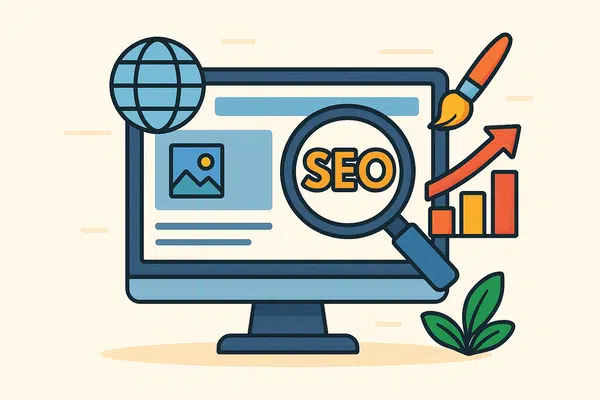The Impact of Website Design on SEO
Introduction to SEO and Web Design
SEO (Search Engine Optimization) is a vital tool that contributes to the success of websites. It is concerned with enhancing a site’s visibility on search engines, which helps attract more visitors and achieve business goals.
Website design is closely linked to the effectiveness of SEO strategies, as design elements play a fundamental role in improving the quality of user experience, which in turn affects search engine rankings.
User experience is one of the key elements that directly impact SEO. Website design must be tailored to provide a positive experience for visitors.
This includes page loading speed, mobile compatibility, and easy navigation between pages. A positive user experience increases engagement and session duration, which boosts SEO rankings.
Furthermore, design components such as content structure, proper use of tags, and image optimization are especially important.
They help search engines better understand the content of the site. Visually appealing and user-friendly designs contribute to higher conversion rates and comply with international web standards, thereby building user trust and indirectly improving SEO performance.
In general, SEO and web design go hand in hand. Search engine optimization doesn’t rely solely on content quality but also requires effective design that balances visual appeal with functionality.
Therefore, it is recommended to ensure coordination between SEO and design teams to achieve optimal results.

Design Elements That Impact SEO
When it comes to website design, several elements play a crucial role in enhancing search engine optimization (SEO). One of the most prominent factors is page loading speed. The faster a page loads, the more likely a visitor will stay longer on the site,
which improves the site’s ranking in search results. Studies show that visitors tend to leave websites that take too long to load, negatively affecting bounce rate—and in turn, SEO ranking.
In addition to loading speed, graphic design significantly influences SEO aspects, as the choice of colors and fonts affects user experience.
For instance, using well-contrasted colors makes text more readable, reducing the chances of visitors leaving the site early. Fonts should align with the site’s visual identity and remain legible across all devices.
Another crucial factor is easy site navigation. A simple and clear navigation structure helps users reach desired content efficiently, making the site more search engine-friendly.
The easier it is for users to navigate, the more content they are likely to explore—thus increasing the time spent on site.
Finally, responsive design is one of the core elements affecting SEO. In today’s world, users access websites through a variety of devices, such as smartphones, tablets, and computers.
Having a responsive website ensures a seamless user experience and offers better SEO performance since search engines prefer sites that adapt to different screen sizes. This adaptability can have a significant positive impact on overall SEO ranking.
The Importance of User Experience in SEO
User Experience (UX) is a fundamental component of search engine optimization (SEO). It plays a crucial role in determining how visitors interact with a website,
which directly affects the site’s ranking in search engine results. A smooth and comfortable browsing experience encourages visitors to spend more time on the site, helping to reduce bounce rate—a positive signal for search engines.
Creating an attractive and functional user interface includes designing pages in a way that makes information easily accessible, enhancing the overall user experience. Designers must ensure that content is visible and easy to read,
in addition to providing well-structured and intuitive navigation menus. Site performance and loading speed are also vital elements, as long loading times can frustrate users and cause them to leave before exploring the content.
Moreover, mobile compatibility has become essential in today’s tech-driven age. The design should accommodate various screen sizes, ensuring a consistent and pleasant experience,
whether users are browsing on smartphones or desktop computers. When improving the user interface, data should be relevant and tailored to user preferences, with a focus on content that sparks their interest.
In summary, enhancing user experience has a direct impact on SEO rankings, as it increases user interaction and decreases bounce rate. By creating a user-friendly interface, websites can outperform competitors and achieve better results in search engines.

Strategies to Improve Web Design for SEO
Improving website design for SEO requires the implementation of well-planned strategies that enhance a site’s performance in search engines. Keywords play a crucial role in this context.
They should be effectively integrated into visual elements such as headings and anchor texts—those used in internal links that guide visitors to other pages on the site. Keywords must be clear and consistent with the page’s content to ensure a better user experience.
Moreover, image optimization is essential. Using appropriate formats and compression ratios helps images load faster, thereby improving site performance. It’s also important to add alternative text (alt tags) to images,
as these tags help search engines understand the image content, improving visibility in search results. Including keywords in these tags further strengthens SEO.
Additionally, managing internal and external links is a powerful tool for improving SEO. It is recommended to create internal links that connect related content, making it easier for users to navigate and increasing time spent on the site.
On the other hand, linking to credible external sources can also enhance SEO rankings. These links should be relevant to the content and provide real value to the reader.
To apply these strategies to existing websites, start by evaluating the current design structure and identifying areas that need improvement.
It’s also crucial to update content, enhance page loading speed, and ensure the site is compatible with various devices. All of these efforts contribute to improved SEO performance, leading to increased traffic and higher rankings in search engine results.







No comment